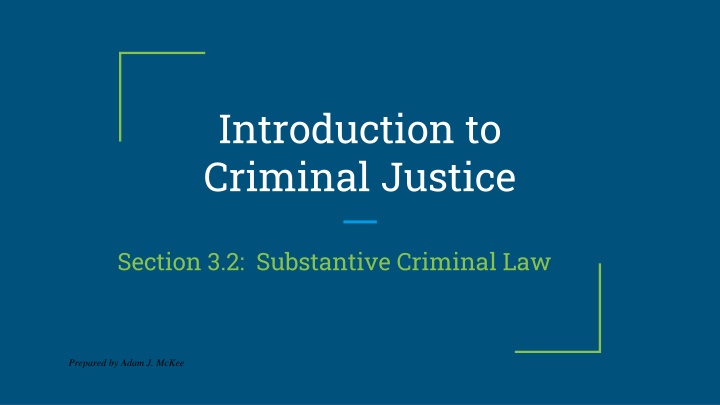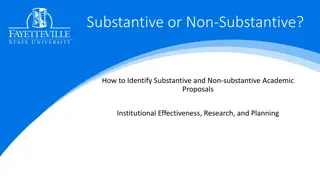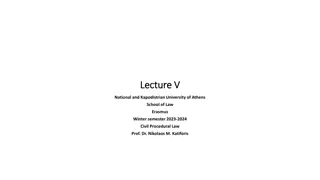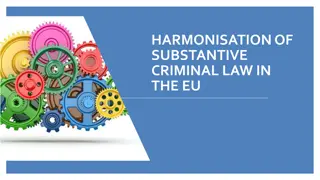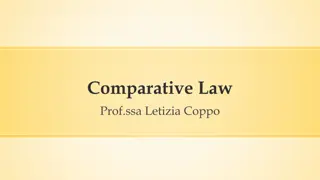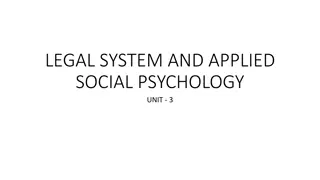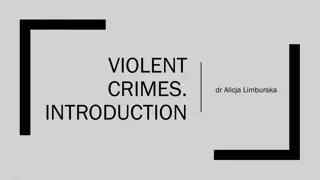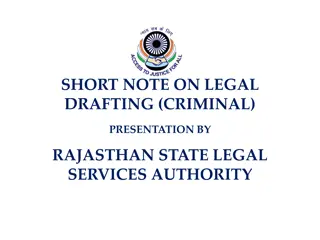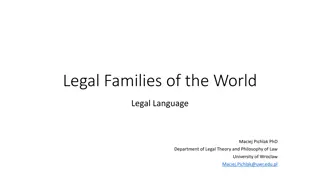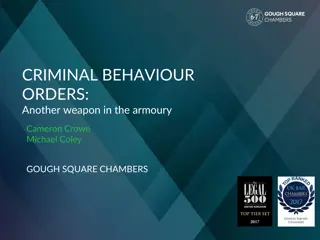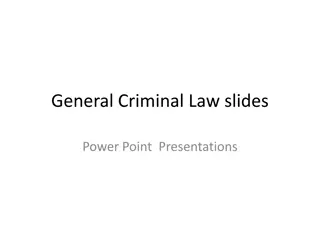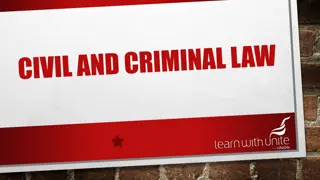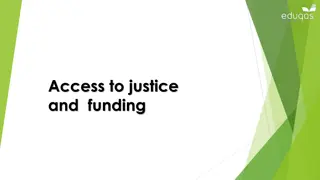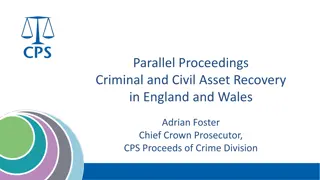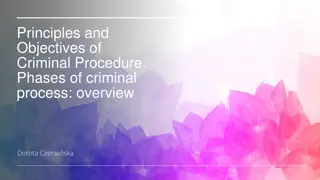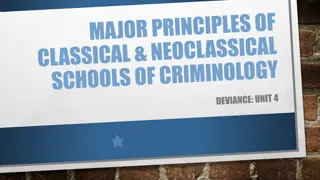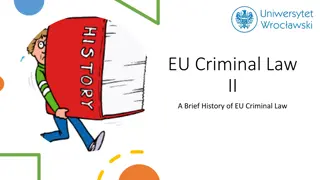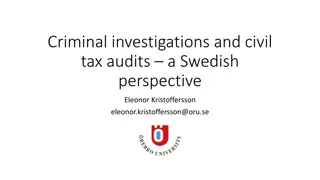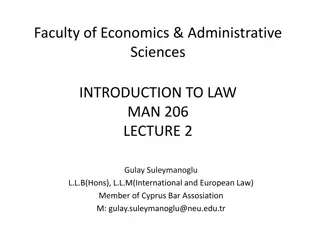Substantive Criminal Law in the American Legal System
Substantive criminal law encompasses the definition of criminal acts and penalties, with a core principle being that there can be no crime without a corresponding law. The American legal system follows the Rule of Law, ensuring that all individuals are subject to legal governance. Constitutional limits, such as prohibiting bills of attainder and ex post facto laws, safeguard against governmental abuse of power. The importance of fair notice and clarity in criminal laws is emphasized to prevent ambiguity and ensure due process.
Download Presentation

Please find below an Image/Link to download the presentation.
The content on the website is provided AS IS for your information and personal use only. It may not be sold, licensed, or shared on other websites without obtaining consent from the author.If you encounter any issues during the download, it is possible that the publisher has removed the file from their server.
You are allowed to download the files provided on this website for personal or commercial use, subject to the condition that they are used lawfully. All files are the property of their respective owners.
The content on the website is provided AS IS for your information and personal use only. It may not be sold, licensed, or shared on other websites without obtaining consent from the author.
E N D
Presentation Transcript
Introduction to Criminal Justice Section 3.2: Substantive Criminal Law Prepared by Adam J. McKee
Defining Criminal Law The criminal law in its broadest sense encompasses both the substantive criminal law and criminal procedure. In a more limited sense, the term criminal law is used to denote the substantive criminal law, and criminal procedure is considered another category of law. Most college criminal justice programs organize classes this way. 2
Substantive Criminal Law Recall that the substantive law defines criminal acts that the legislature wishes to prohibit and specifies penalties for those that commit the prohibited acts. For example, murder is a substantive law because it prohibits the killing of another human being without justification. 3
No Crime Without Law It is fundamental to the American way of life that there can be no crime without law. This concept defines the idea of the Rule of Law. The rule of law is the principle that the law should govern a nation, not an individual. The importance of the rule of law in America stems from the colonial experience with the English monarchy. It follows that, in America, no one is above the law. 4
Constitutional Limits Unlike the governments of other countries, the legislative assemblies of the United States do not have unlimited power. The power of Congress to enact criminal laws is circumscribed by the Constitution. These limits apply to state legislatures as well. 5
Bills of Attainder and Ex Post Facto Laws A bill of attainder is an enactment by a legislature that declares a person (or a group of people) guilty of a crime and subject to punishment for committing that crime without the benefit of a trial. An ex post facto law is a law that makes an act done before the legislature enacted the law criminal and punishes that act. The prohibition also forbids the legislature from making the penalty for a crime more severe retroactively. Both of these types of laws are strictly prohibited by the Constitution. 6
Fair Notice and Vagueness The due process clauses of the Fifth and Fourteenth Amendments mandate that the criminal law afford fair notice. The idea of fair notice is that people must be able to determine exactly what is prohibited by the law, so vague and ambiguous laws are prohibited. If a law is determined to be unclear by the Supreme Court, it will be struck down and declared void for vagueness. Such laws would allow for arbitrary and discriminatory enforcement if allowed to stand. 7
The First Amendment The First Amendment to the United States Constitution guarantees all Americans the freedom of expression. Among these expressions are the freedom of religion and the freedom of speech. In general, Americans can say pretty much whatever they like without fear of punishment. 8
The First Amendment and Criminal Law Any criminal law passed by the legislature that infringes on these rights would not withstand constitutional scrutiny. There are, however, some exceptions. 9
Clear and Present Danger When the health and safety of the public are at issue, the government can curtail the freedom of speech. One of the most commonly cited limiting principles is what has been called the clear and present danger test. This test, established by the Supreme Court in Schenck v. United States (1919), prohibits inherently dangerous speech, such as falsely shouting fire! in a crowded theater. 10
Fighting Words Another prohibited type of speech has been referred to as fighting words. This means that the First Amendment does not protect speech calculated to incite a violent reaction. 11
Other Unprotected Speech Other types of unprotected speech include hate speech, profanity, libelous utterances, and obscenity. These latter types of speech are very difficult to regulate by law because they are very hard to define and place limits on. The current trend has been to protect more speech that would have once been considered obscene or profane. 12
Freedom of Religion The freedom to worship as one sees fit is also enshrined in the Constitution. Appellate courts will strike down statutes that are designed to restrict this freedom of religion. The high court has protected door-to-door solicitations by religious groups and even ritualistic animal sacrifices. 13
Limits on Religious Freedom The Court, however, has not upheld all claims based on the free exercise of religion. Statutes criminalizing such things as snake handling, polygamy, and the use of hallucinogenic drugs have all been upheld. 14
The Freedom of Assembly The First Amendment protects the right of the people to assemble publicly, but it is not absolute. The courts have upheld restrictions on the time, place, and manner of public assemblies, so long as those restrictions were deemed reasonable. The reasonableness of such restrictions usually hinges on a compelling state interest. The freedom of assembly does not protect conduct that jeopardizes the public health and safety. 15
The Second Amendment The constitutionally guaranteed right to keep and bear arms in the Second Amendment is by no means absolute has been the source of much litigation and political debate in recent years. The Supreme Court has established that the second Amendment confers a right to the carrying of a firearm for self-defense, and that right is applicable via the Fourteenth Amendment to the states. 16
Restrictions on the Second Amendment Typical restrictions include background checks and waiting periods. Some jurisdictions highly regulate the concealing, carrying, and purchase of firearms, and many limit the type of firearms that can be purchased. Many criminal laws have enhanced penalties when they are committed with firearms. Most gun laws and concealed carry laws vary widely from jurisdiction to jurisdiction. 17
Eighth Amendment The Eighth Amendment to the United States Constitution prohibits the imposition of Cruel and Unusual Punishments. Both the terms cruel and unusual do not mean what they mean in everyday usage; they are both legal terms of art. The Supreme Court has incorporated the doctrine of proportionality into the Eighth Amendment. 18
Doctrine of Proportionality Proportionality means that the punishment should fit the crime, or at least should not be grossly disproportionate to the offense. The idea of proportionality has appeared in cases that considered the grading of offenses, the validity of lengthy prison sentences, and whether the imposition of the death penalty is constitutional. The legal controversies of three strikes laws and the death penalty will be discussed at greater length in a later section. 19
The Right to Privacy Most American s view the right to privacy as a fundamental human right. It is shocking, then, to find that the Constitution never expressly mentions a right to privacy. The Supreme Court agrees that such a right is fundamental to due process and has established the right as being inferred from several other guaranteed rights. Among these are the right of free association, the prohibition against quartering soldiers in private homes, and the prohibition against unreasonable searches and seizures. 20
The Right to Privacy and Criminal Law The right to privacy has been used to protect many controversial practices that were (at least at the time) socially unacceptable to large groups of people. Early courts decided that laws prohibiting single people from purchasing contraceptives were unconstitutional based on privacy rights arguments. 21
Case Law The right to an abortion established in Roe v. Wade (1973) hinged primarily on a privacy rights argument. More recently, in Lawrence v. Texas (2003), the court ruled that laws prohibiting private homosexual sexual activity were unconstitutional. In the Lawrence case, privacy rights were the deciding factor. 22
